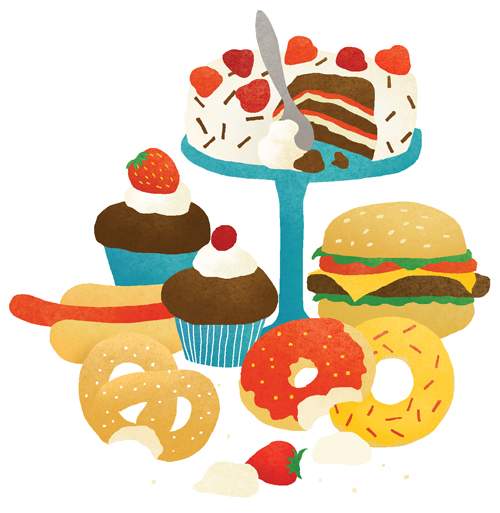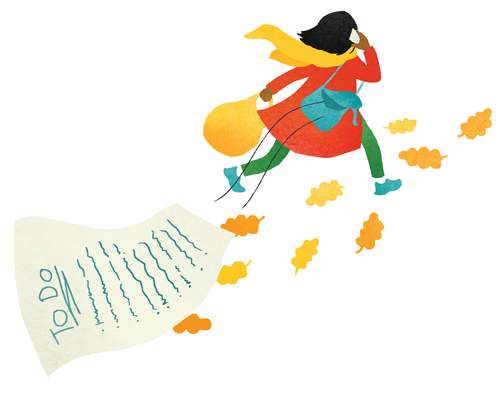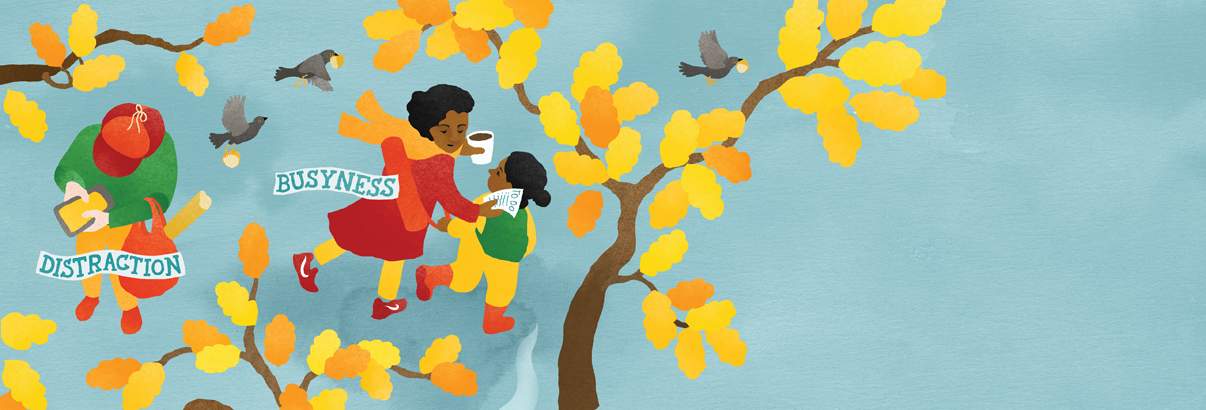Consider these two experiences:
It’s a crisp early autumn day as you begin walking through the woods, sensing fall in the coolness of the air on your face. You see the play of light and shade as the sun shines through the leaves swaying in the breeze. You feel the weight of your body on your feet as you walk along the path, and feel the beating of your heart as the path inclines up a hill. You hear the chirp of the birds, the sound of the season’s last cicadas, and the distant rumble of a truck. Thoughts of daily life come and go, but don’t interfere with your enjoyment of the simple pleasure of a walk in the woods. Nothing special, yet you feel alive and present, open to your experience and to life.
Take the same setting, but this time as you begin to walk your mind is caught up in worries about all the work you have to do and fears that something important will fall through the cracks. You remember a difficult encounter with your boss earlier in the week and worry about what that might mean for your future. This thought hooks on to concerns about the poor grades your teenage son received on his latest report card, and worries about the friends he’s been hanging out with. You take your phone out of your pocket to see if any important messages have landed in your inbox since you began your walk.
You’re barely aware of your surroundings as your focus is consumed by your anxious thoughts. Like a seesaw, your mind flips back to ruminating on the past and forward into fears and anxiety about the future. If you stopped to pay attention, you might notice that your body is tense and tight, reflecting your mental state. You’re distant from your bodily experience and your environment.
It’s easy to develop patterns and habits that take us away from our present experience into rumination, worry, and fear, which, in turn, lead to stress and suffering. It’s easy to slip into overeating or over-drinking or other unhealthy behaviors without awareness, offering momentary relief but separating us from our deepest intentions.
Fortunately, mindfulness provides practices and skills to help us change unhealthy habits and live in greater harmony with life.
Bringing attitudes of mindfulness to unwanted habits
Different kinds of habits have different feelings associated with them, but all can be changed when met with a kind, interested, and accepting awareness. There are four main categories of habits—habits of wanting; habits of distraction; habits of resistance; and habits of doing—that encompass many of the most common behaviors we seek to change.

The 4 Main Categories of Habits:
1) Habits of Craving
Habits of wanting, craving, or addiction have an energy and feeling tone of moving toward something we desire. The body and mind focus in on the object, be it a drink, drugs, food, cigarettes, or sex, or any other object of desire, and our sense of well-being and happiness becomes tied to getting what we crave. Working mindfully with habits of wanting means opening fully to the feeling of wanting as it manifests—in the body, the emotions, and the mind. If something triggers the urge, you can open to the sensations, feelings, and emotions and say “yes” to them and meet them with kindness, interest, and acceptance. If a thought arises, such as, “I’ll feel better if I have a smoke/drink,” meet that thought with kindness. Choose to stay with what’s alive in the body and the emotions without acting on it. When you learn to stay with the uncomfortable, unpleasant, or difficult feelings, you weaken the hold that the craving has over you.
2) Habits of Distraction
If you become aware that your attention has moved into an unhealthy habit of distraction, such as spacing out watching TV or surfing the Internet—or if you catch yourself before moving into it—bring close attention to your bodily experience and emotions. Stay with these sensations and feelings, then bring to mind the question: What would I have to experience if I didn’t turn toward my habitual behavior? You may locate a feeling of tightness or numbness, perhaps, or a restless feeling. Meet the experience with a kind, curious, and accepting attention. See how, when met in this way, the feeling will come and go in its own time.
If something triggers the urge to move toward an object you crave, you can open to the sensations, feelings, and emotions that arise—choosing to stay with what’s alive in the body and the emotions without acting on it.
3) Habits of Resisting
Habits of resisting, which manifest as frustration, annoyance, impatience, anger, judgment, and similar emotions and mind states, tend to have a different feeling tone. We feel as if we’re defending ourselves, resisting a threat, or protecting ourselves from something that will harm us. Often we’ll feel tightness, tension, contraction, agitation, heat, or other “fight-orflight” sensations. The accompanying thoughts or beliefs in our mind may urge us to act in a way that will change this unpleasant situation or experience.
We can meet the habits of resistance by bringing our attention back to “what am I experiencing right now?” then meet what is here with a kind, curious, and accepting awareness. Bringing awareness to your breath helps to ease feelings of tightness and tension. Putting your hand on your heart can help temper thoughts of “I need to do something.” Sending a wish of peace and well-being to yourself, perhaps whispering “may I be peaceful,” can create a sense of inner space within which the difficult experience and sensations can be held. Here, too, the practice is to bring a kind, curious, and accepting attitude to what is present—choosing to stay with your direct experience rather than moving into habitual behavior.
4) Habits of Busyness
Finally, we can respond to habits of doing—the feeling that we’re always on our way somewhere, feeling that something bad will happen if we don’t keep moving and getting things done—with the same attitude of kind, interested, and accepting awareness. We begin by coming back to what we are feeling now, physically, emotionally, mentally. We think, “things might be OK if I can just accomplish the next task.” We can feel frenetic, agitated, intense, or stressed out. Mindfulness invites us to experience all the sensations and emotions associated with that energy without identifying with it. Mindfulness practice helps prevent us from getting swept up in the story of “I need to get this done or things will fall apart.”
These four kinds of habits are not mutually exclusive. When we feel a craving for something that we think will make us feel good, such as eating something sweet, we are often, at the same time, wanting to avoid an unpleasant feeling—for example, tension, worry, tightness, or numbness. Similarly, when we disconnect from the present and spend large amounts of time online, there is often a feeling of discomfort, anxiety, or tension that we’re subconsciously seeking to escape. With each of these habitual patterns, the remedy is the same: to return to our present-moment experience and meet it with interest, friendliness, and acceptance.
Untangling ourselves from habitual thoughts and beliefs
Much of the stress, anxiety, and suffering in our lives comes from not bringing wise attention to our thoughts and beliefs, and treating them as “true.” We get swept up by the stories we tell ourselves. Our habit patterns play an important role in perpetuating thoughts and beliefs that lead to suffering. You might experience a loss or feel lonely or anxious and comfort yourself by eating something sweet, having a glass of wine, or zoning out in front of the TV for a few hours. That’s fine, but if you obsessively repeat the mindless behavior in response to the same difficult emotion, a habit of responding in this way develops. Your mind associates the temporary release from unpleasant feelings with the new behavior and your thinking reinforces the behavior. I feel better when I have a couple of beers. I’ll feel sad/lonely if I don’t have a cigarette.
Much of the stress, anxiety, and suffering in our lives comes from not bringing wise attention to our thoughts and beliefs, and treating them as “true.”
Habits of resisting or aversion—yelling at one’s spouse or kids, responding to experience with frustration, anger, impatience, harsh judgment of ourselves or others—tend to have the underlying thought pattern, this needs to be different for me to feel OK. Or if I don’t change this, something really bad will happen.
With habits of distraction—such as constantly checking our phone or spending excessive time watching TV—the underlying thinking is typically that our present experience is boring or unpleasant, and that doing something familiar will be more interesting or enjoyable.
Habits of doing—when we’re leaning in to the next thing we need to get done with a tense energy—tend to have the underlying thought pattern that something bad will happen if I don’t keep moving.
Mindfulness provides skills and practices to loosen our identification with thoughts, helping us see that the content of a thought is not inherently “true.” With attention, thoughts can be observed and met with wisdom rather than being acted out in habitual ways. For example, when a familiar stimulus triggers the thought, some ice cream would be nice now, we can observe this as “wanting” or “wanting thought,” rather than automatically going to the freezer and scooping out a bowl of ice cream.
Mindfulness provides skills and practices to loosen our identification with thoughts, helping us see that the content of a thought is not inherently “true.”
We can deepen our awareness of the emotions and bodily feelings that often underlie and spur our habits of thought and action. And where our thoughts have hardened into beliefs that perpetuate unhealthy habits, we can investigate these beliefs and untangle ourselves from them.

Observing thoughts, letting them come and go
One of the most powerful realizations that we can come to in mindfulness practice is to see that we can bring awareness to thoughts and beliefs rather than being lost in them or ruled by them. There is all the difference in the world between, on the one hand, bringing awareness to feeling angry at something a colleague said—feeling the tension and heat in our face and chest, paying attention to our feelings of annoyance or the thoughts of what we might say—and, on the other hand, being swept up in the anger and the narrative in our mind of how wrong they are, or what we’ll say to them.
When we bring awareness to our thoughts, choices open up for us—including the choice not to believe or identify with our thoughts. When we fail to bring awareness to our thoughts, however, we have little choice but to act out old thought patterns and follow them.
So, an essential mindfulness skill is to develop a healthy relationship with our thoughts—seeing thoughts as ephemeral products of the mind rather than the truth. When we practice mindfulness of breathing, or other objects of awareness, we may get caught up in planning, worrying, daydreaming, or remembering something from the past. When we become aware that our attention has shifted, we pause and invite our attention back to our breath in a kind, gentle, and non-judging way. It can be helpful to make a mental note, “thinking,” “planning,” “daydreaming,” or “worried thought.” The practice of naming or noting “thinking” can help us observe thoughts as passing phenomena, rather than getting lost in the content of the thoughts.
An attitude of kindness and non-judgment helps us develop a healthy relationship with our thoughts; there is no need to try to empty the mind. If thoughts can be experienced without resistance, clinging, or judgment, they cease to be a problem. If they’re experienced as “problematic” in any way, this is an indication that our relationship with them calls for wise attention.
Bringing awareness to thoughts as thoughts and choosing to come back to the present by letting go of the narrative helps us loosen our identification with the thoughts and beliefs that can keep us locked in unhealthy habits.
Untangling thoughts from feelings and emotions
The practice of bringing awareness to our present-moment experience and returning attention to our primary focus when we become aware that we have drifted into thought is an essential mindfulness skill.
At times, though, our thoughts are part of a constellation of sensations, emotions, and urges that can perpetuate unhealthy habits if we don’t bring awareness to them as well. For example, a memory might bring on a feeling of sadness with heavy bodily sensations around the heart and the eyes, and these feelings might trigger an urge to space out by going online—particularly if this is an established experience. We might find ourselves going from site to site on the Internet without any clear purpose or any awareness that we have consciously made a choice to “check out.”
Without awareness we often act in habitual ways that don’t serve us. But if we allow ourselves to experience them, we can untangle the complex web of sensations, emotions, and urges that accompany our thoughts and choose to act in ways that serve our deeper happiness and well-being.
If you are using the breath as your meditation object or “anchor,” you can simply return your attention to your breathing when you become aware that you’ve been lost in thought. However, if you find that you keep being pulled back to a recurrent thought—for example, a painful memory or a fearful or anxious thought that has a strong charge to it—then, rather than simply bringing attention to the breath, bring awareness to whatever sensations or emotions are present in the body. If there’s tightness in the chest or belly, open fully to the sensations. Breathe into them and let them come and go in their own time, meeting them with kindness and acceptance. Open to whatever emotions are present—anger, for example, by making a note of “anger,” if it’s helpful. If worried, sad, or fearful thoughts arise, simply bring awareness to them, noting “thinking,” or “sad thought.”
Let each part of your experience be known in its own field—thoughts simply observed as thoughts, emotions as emotions, sensations as sensations, allowing each experience to come and go in its own time, riding the waves of the experience. In this way, we untangle the otherwise unexamined constellation of emotions, sensations, thoughts, and urges that can fuel unhealthy habit patterns.

Investigating beliefs and narratives
It is natural that when we think and act in particular ways, over time we can come to believe that we don’t have any choice in relation to these thoughts or actions. We may even believe, “this is who I am.”
If we’ve developed a habit of responding angrily to small annoyances or slights, we can easily believe, “I’m an angry person” or “people are stupid.”
If we’ve smoked cigarettes for many years, we may believe, “I’m a smoker” or “I don’t have the willpower to quit”—and these beliefs can help perpetuate the unhealthy behavior.
If we aimlessly surf the web for the first hour of work, we may believe, “I’ll never be productive at work,” and that we can’t be mindful when we sit down at our desk in the morning.
If we’re in a constant state of stress, rushing to get everything done, we might believe, “I’m never going to be able to keep up.” And the belief helps fuel the stressful state.
Over time, the repetition of unhealthy habits of thought and action can solidify beliefs that identify us with the habits and limit the possibility of changing these patterns.
It’s important to investigate these beliefs and to see the ways in which we’re identifying with them. Seeing that these narratives are a creation of our minds can allow us to untangle ourselves from them so that they cease to fuel unhealthy habit patterns.
We can begin by asking, Is this really true? Is it true that “I’m an angry person” or “I don’t have the willpower to quit” or “I’ll never be able to get all these things done”?
Or is this a belief or story that I’ve developed and become identified with over time that, in fact, is not solid, is not “me,” and can be let go of?
We can counter negative beliefs and narratives, which often are accompanied by never or always—with examples that call our story into question. For instance, if the underlying belief is, I’m indecisive and unfocused, you might think about a Saturday morning when you were up early and focused for a long hike in the mountains.
You can engage in an inquiry into the beliefs that help perpetuate unhealthy habits. You can take some time in your meditation period to sit with these questions: What am I believing? Is this really true? How is it to live with this belief? How would it be to live without this belief? Who would I be without this belief?
Working with your thoughts through these practices of mindfulness and inquiry helps weaken any long-standing beliefs that fuel and perpetuate unhealthy habits, enabling you to live more freely.
Mindfulness Practice: Awareness of habits—before, during, and after
Here are some examples of ways we can work with habits in these three different phases.
• Before: Bring awareness to the habit that you want to change and think about the situations or conditions that trigger the habit. Are there actions you can take to avoid acting out the habit? What might be an alternative, healthier choice? For example, if you frequently snack on sweets when you’re feeling anxious, uncertain, confused, or lonely, ensure that you don’t have sweets in the house. Purchase healthier foods, such as nuts or fruit, to be on hand when a wish to have a snack arises.
• During: Work with the trigger, urge, or craving to act in a habitual way: Pay attention to the context or environment in which the habit typically arises—the place, time, people, sights, sounds, smells. When you first become aware of an urge to act, pause, take a few deep breaths and bring awareness to your internal experience. What is predominant? Is it a bodily feeling, such as tightness in the stomach or watering of the taste buds? Is it a strong emotion such as anxiety that you have responded to with comfort food in the past? Is it a combination of sensations, emotions and thoughts?
Make a conscious choice to remain aware of your direct experience, rather than acting on the craving. Notice how the sensations, emotions, and thoughts, begin, stay for a time, and pass when you meet them with kind attention. Learning to experience strong feelings and stay with them is a key to changing unhealthy habits.
• After: If you’ve brought mindfulness to a stimulus or craving that has led in the past to an unhealthy habit but you’ve resisted taking the habitual path, let yourself feel whatever comes up. Perhaps it’s a feeling of relief or release, or gratitude, or optimism. Take these feelings in. Allow yourself to experience with appreciation any bodily sensations, emotions, or thoughts.
If you acted upon the urge or stimulus in a habitual way, don’t judge or criticize yourself. Rather, meet whatever feelings come up with kindness. If self-judgment, harsh criticism, or feelings of frustration or pessimism arise, meet them with friendliness. Revisit what matters most to you and how working to abandon this unhealthy or unwanted habit supports your deepest intentions. Remember you can begin again in any moment—and choose to begin again.





